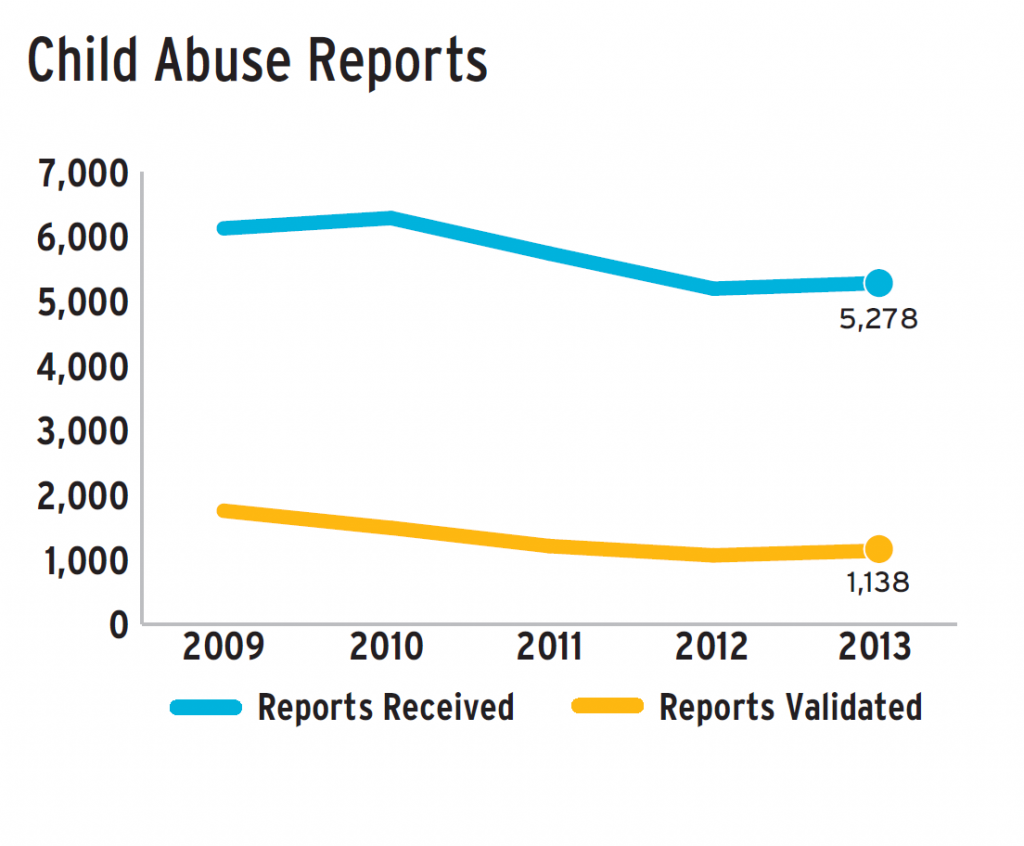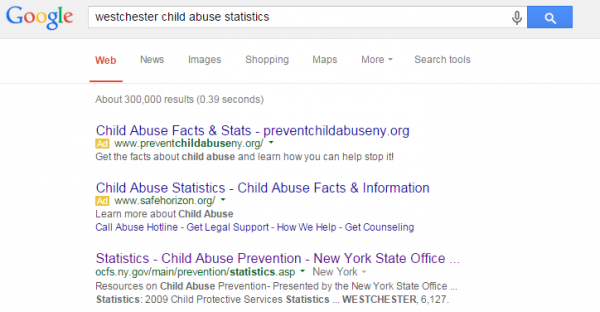
Source: New York State Office of Children and Family Services, 2013 Monitoring and Analysis Profiles with Selected Trend Data: 2009-2013.
This post is part of a series of articles about the recently released 2015 Children By the Numbers Data Bulletin. In this series, we tell the stories behind the numbers and statistics featured in the data bulletin.
April is National Child Abuse Prevention Month in the US. I admittedly am uneasy about the notion of “celebrating” child abuse prevention, because I wish there wasn’t the need for child abuse prevention in the first place.
Child abuse is a crime that lingers long after the abuse has ended. The physical and psychological effects of child abuse can last for years if not decades and those same insidious effects can be passed on to future generations. Child abuse has a financial cost as well: a 2012 study from the Centers for Disease Control and Prevention (CDC) estimated that the lifetime cost of nonfatal child abuse for a single child is $210,012 in 2010 dollars. This estimate includes the costs of health care, productivity losses, child welfare, criminal justice, and education throughout that child’s lifetime. For these reasons, it is particularly important to keep a constant and steady eye on child abuse in Westchester County.
But where’s the data?
Child abuse data for New York City is readily available through the City’s Monthly Flash Indicators and the annual Mayor’s Management Report. However, in Westchester, the non-existence of published, timely, child welfare data that doesn’t require the services of a bloodhound to find it is a maddening, infuriating fact of life here in this county. A Google search for Westchester child abuse statistics initially brought up data from 2009.
Fortunately, New York State does publish more up-to-date child welfare data via the Office of Children and Family Services (OFCS). Unfortunately, we can only obtain yearly figures from OCFS via County Monitoring and Analysis Profiles; the most current year available is 2013. The practice of publishing monthly data, the standard in New York City, has not carried over to Westchester County, much less New York State.
So, upon review of the data that IS available what do we find?
Between 2012, there was a slight increase:
in the number of child abuse reports received…
…and child abuse reports indicated (found to be valid).
It is important to note that these one-year increases are nevertheless part of a five-year trend of decreasing reports and decreasing indication rates for Westchester County as well as New York State. However, from 2012-2013, the total number of child abuse reports, as well as the number of reports validated, decreased in New York State. Given that this is only one year of data, it’s difficult to ascertain at this point whether or not the increase in Westchester child abuse reports is an ongoing trend, or a statistical blip. By the way, we don’t have a really good explanation of why the numbers have been on such a downward (positive) trend. Is child abuse really declining? Are people reporting fewer incidents or is the State accepting fewer reports?
And here is where the lack of monthly data becomes especially frustrating. Perhaps the increase in reporting could be attributed to a one-time event (ex. increased media coverage due to a highly publicized child abuse case). Or perhaps the increase presages a steady climb in child abuse reports that would have continued in 2014. Without the numbers, we do not have a clear idea of what actually happened in 2013, and we do not have a clear idea of what is happening now.
Make it easy
Child abuse is a complex, complicated issue – it requires the utmost dedication and focus to send it to its demise. That said, there are things — EASY things — that the local and state governments could do to make it easier for the community to maintain its focus. Here are two recommendations, which are so mind-numbingly easy it’s unbelievable. Both recommendations would take five minutes to do.
- Westchester County should, at the very least, post the link of the current County Monitoring and Analysis Profile on the Westchester County Department of Social Services website.
- Government websites, including New York State, should use Search Engine Optimization techniques to make it easy for people to find current child abuse statistics via search engines such as Google. One easy technique: make sure that webpage copy mentions the type of statistics listed on the page. It’s disconcerting to realize that on the page listing county profiles with child abuse statistics, the phrase “child abuse” never appears in the website copy. It only appears as a menu item on the website header, and that obviously isn’t enough for the search engines to pick up on it.
Our other recommendations? Let’s talk about publishing county data, and not just child abuse data, on a much more regular basis. We realize that there can be significant obstacles, such as a lack of adequate IT infrastructure, in reporting data on a monthly basis. But Westchester should be the leader in open government and data transparency. It is painfully obvious that it is not, and our children will suffer as a result.



